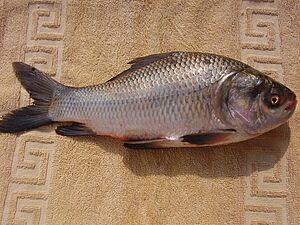Catla facts for kids
Quick facts for kids Catla |
|
|---|---|
 |
|
| A young Catla fish | |
| Conservation status | |
| Scientific classification | |
| Synonyms | |
|
The Catla fish, also known by its scientific name Labeo catla, is a very important freshwater fish found in South Asia. It belongs to the carp family, called Cyprinidae. You can find Catla naturally in the rivers and lakes of northern India, Bangladesh, Myanmar, Nepal, and Pakistan. People have also moved this fish to other parts of South Asia, and it is often farmed for food.
In some areas, like Nepal and parts of India, people call the Catla fish "Bhakura."
What Does Catla Look Like?
Catla fish have a big, wide head and a lower jaw that sticks out. Their mouth points upwards. They have large, greyish scales on their back and white scales on their belly. These fish can grow quite large, sometimes reaching up to 182 centimeters (about 6 feet) long and weighing up to 38.6 kilograms (about 85 pounds)!
What Do Catla Eat?
Catla fish usually feed near the surface or in the middle of the water. Adult Catla mostly eat tiny water animals called zooplankton. They use special comb-like parts in their gills, called gill rakers, to filter these small creatures from the water. Younger Catla fish eat both zooplankton and tiny water plants called phytoplankton. Catla fish are ready to have babies when they are about two years old and weigh around 2 kilograms (about 4.4 pounds).
Catla's Scientific Name
The Catla fish used to be the only species in a group called Catla. However, scientists later realized that this group name was actually the same as another group called Gibelion. More recently, experts who keep track of fish names, like the Catalog of Fishes, have moved the Catla fish into the Labeo group.
Sometimes, people have confused the Catla fish with another very large fish from Southeast Asia called the giant barb (Catlocarpio siamensis). This is because both fish look very similar, especially with their very large heads.
Farming Catla
Catla is one of the most important freshwater fish raised in aquaculture (fish farming) across South Asia. Farmers often grow Catla in ponds along with other carp fish, like the roho labeo (Labeo rohita) and mrigal carp. This way of farming different fish together is called polyculture.
The amount of Catla produced by farming has grown a lot since the early 2000s. By 2012, about 2.8 million tons of Catla were being produced each year! Catla fish are usually sold and eaten fresh in local areas and nearby regions. They are often transported on ice to keep them fresh. Consumers usually prefer to buy Catla fish that weigh between 1 and 2 kilograms (about 2.2 to 4.4 pounds).



